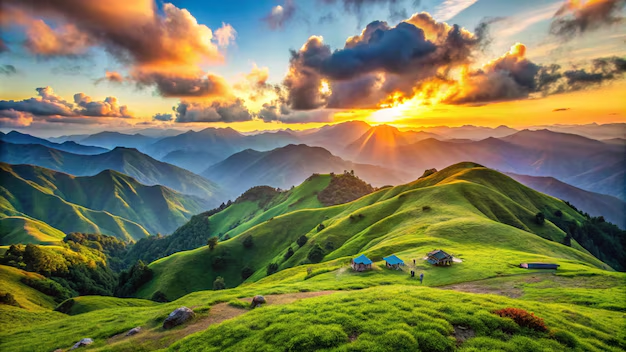Wugong Mountain, located in western Jiangxi Province, China, is a breathtaking destination renowned for its sprawling alpine meadows, dramatic sea of clouds, and rich cultural heritage. As one of the three great mountains south of the Yangtze River, alongside Mount Lushan and Mount Hengshan, it holds a prestigious place in Chinese history and natural beauty. Designated a UNESCO World Geopark in March 2024, Wugong Mountain offers hikers, campers, and nature lovers an unforgettable adventure with its highest peak, Baihe Peak (Golden Summit), standing at 1,918.3 meters. This guide will help you plan a memorable trip to this “Grassland in the Clouds.”








A Travel Guide to Wugong Mountain
Why Visit Wugong Mountain?
Wugong Mountain is a paradise for outdoor enthusiasts, famous for its vast meadows that ripple across high-altitude ridges, resembling a green carpet under the sky. Its sea of clouds, especially at sunrise, creates a dreamlike spectacle, while waterfalls, ancient temples, and Taoist relics add cultural depth. The mountain’s diverse geological features, including Jurassic granite “stone forests” and karst formations, make it a haven for geologists and photographers. The annual International Camping Festival (July–September) attracts thousands, with colorful tents dotting the landscape, creating a vibrant scene. Whether you seek a challenging hike, a serene camping experience, or a glimpse into Taoist and Buddhist heritage, Wugong Mountain delivers.
How to Get There
Wugong Mountain spans Luxi County (Pingxiang City), Anfu County (Ji’an City), and Yuanzhou District (Yichun City). The primary access point is Pingxiang, a city 280 km from Nanchang, Jiangxi’s capital. Here are the main transportation options:
By Train: Take a high-speed train to Pingxiang North Station from major cities like Shanghai (4–5 hours, ¥300–500), Guangzhou (3–4 hours, ¥250–400), or Nanchang (1–1.5 hours, ¥50–100). From Pingxiang North, a taxi or bus to the scenic area (Luxi County) takes about 40–60 minutes (¥50–80). Alternatively, trains to Yichun Station or Ji’an Station are viable, followed by a 1–2-hour drive to the mountain.
By Air: The nearest airport is Nanchang Changbei International Airport (280 km away). From there, take a high-speed train or bus to Pingxiang. Yichun Mingyue Mountain Airport (80 km from the scenic area) is closer but has limited domestic flights.
By Bus: From Pingxiang’s long-distance bus station (near Pingxiang Railway Station), regular buses run to Luxi County or the Wugong Mountain scenic area (¥20–40, 1–1.5 hours). Direct coaches from Nanchang or Changsha (Hunan, 100 km away) are also available.
By Car: Rent a car or hire a private driver from Pingxiang or Nanchang. The drive from Pingxiang to the scenic area takes about 1 hour via well-maintained roads. Parking is available at the base (¥10–20/day).
Tip: Book train tickets in advance via Trip.com or ask a local contact for help, as English support may be limited. Most locals in the area do not speak English, so a translation app is recommended.
Best Time to Visit
Spring (March–May): Blooming azaleas and mild weather (15–25°C) make this ideal for hiking. Meadows are vibrant, and waterfalls are at their fullest. Summer (June–August): Lush greenery and cooler mountain temperatures (20–30°C) attract campers. The International Camping Festival (July–September) is a highlight, but expect crowds.
Autumn (September–November): Crisp air (10–20°C), clear skies, and fewer crowds make this the best season for sea-of-clouds viewing and sunrise hikes. Winter (December–February): Snow and rime ice create a magical landscape, but icy trails and cold temperatures (0–10°C) make hiking challenging. Not recommended for novices.
Weather Tip: Check the forecast before hiking, as fog and rain can reduce visibility and make trails slippery. The sea of clouds is most spectacular before or after rain.
Tickets and Opening Hours
Opening Hours: 7:00 AM–5:00 PM daily (last entry at 4:00 PM). Cable cars operate from 8:00 AM–4:30 PM.
Ticket Prices: Entrance fee: ¥80 (discounts for students and seniors, ¥40–60). Zhong’an Cable Car (to Ziji Palace): ¥50 one-way, ¥80 round-trip. Golden Summit Cable Car: ¥50 one-way, ¥80 round-trip. Combo tickets (entrance + cable cars): ¥150–200.
Booking: Purchase tickets on-site or via Trip.com. During peak seasons (spring, autumn, and camping festival), book cable car tickets in advance to avoid long queues.
What to See and Do
Wugong Mountain is divided into several scenic areas, with the Golden Summit and Fayunjie being the most popular. Here’s a breakdown of key attractions and activities:
Golden Summit (Baihe Peak): The highest peak in Jiangxi (1,918.3 m), offering panoramic views of meadows and clouds. It’s a must-visit for sunrise hikes. Stone Drum Temple (Shigu Temple): A 700-year-old temple at the summit’s base, renamed by Emperor Qianlong for its drum-like stone struck by streams. Ziji Palace: A Yuan Dynasty Taoist temple halfway up, known for its intricate Taoist carvings and cultural significance.
Fayunjie Scenic Area: At 1,600 m, this area is the best spot for sea-of-clouds viewing, especially before rain. Its expansive meadow, one of China’s three most beautiful alpine meadows, is perfect for camping and photography.
Hiking Routes: Easy Route (3–5 hours): Start at Stone Drum Temple, take the Zhong’an Cable Car to Ziji Palace, walk the Fuxing Valley Plank Road, and ride the Golden Summit Cable Car to the summit. Return via the same route. Ideal for beginners. Moderate Route (6–8 hours): Hike from Guan Yinyan to Golden Summit, passing waterfalls like Jinhusajiu and Couple Waterfall. Descend via cable car. Challenging Route (10–12 hours): Trek the full ridge from Mingyue Mountain to Fayunjie to Golden Summit. Recommended for experienced hikers with good fitness.
Camping: Camp in the alpine meadows for a “million-star hotel” experience. Rent tents (¥100–200, including sleeping bag and mattress) or bring your own (¥10–20 site fee). The summit can be windy. The International Camping Festival (July–September) features vibrant tent villages and cultural events.
Waterfalls and Natural Sites: Explore Jinhusajiu Waterfall, Couple Waterfall, Red Rock Valley Waterfall, and Seven Immortals Pool on the descending trails. These crystal-clear streams are perfect for photos. The Fuxing Valley Plank Road offers thrilling views of steep cliffs and forests.
Cultural Exploration: Visit ancient altars and temples blending Taoist and Buddhist influences. The Sheep and Lion Curtain, a cluster of unique peaks, is nicknamed “Small Mount Huang” for its dramatic rock formations.
Where to Eat
On the Mountain: Limited dining options include small inns at Golden Summit and Fayunjie selling instant noodles, snacks, and water (¥10–30, higher than market prices). Bring your own food (e.g., compressed biscuits, chocolate) to save money and ensure supply.
At the Base: Restaurants in Luxi County or Pingxiang offer Jiangxi specialties like Nanchang mixed rice noodles, Wugongshan Yunwu Tea, and Anfu tofu (¥20–50/meal). Note that Jiangxi cuisine is very spicy, so specify “no chili” if preferred.
Tip: Pack enough water (2–3 liters) and high-energy snacks for hikes, as vendors are scarce on trails.
Where to Stay
On the Mountain: Basic guesthouses at Golden Summit and Fayunjie offer rooms (¥100–300/night) with limited power (2–3 hours) and hot water. Book early during peak seasons. Camping is the most popular option, with tent rentals widely available. Bring warm clothing for chilly nights (5–15°C).
At the Base: Luxi County: Budget hotels like Wugongshan Hotel (¥100–200/night) or mid-range options like Vienna Hotel (¥200–400/night). Pingxiang: More choices, including Holiday Inn Express (¥300–500/night) or hostels (¥50–100/night).
Nearby: Combine your trip with Tianmu Hot Springs Resort near Yichun (¥250–300/night, including hot springs access) for post-hike relaxation.
Booking: Use Ctrip or Booking.com for deals. Reserve in advance during the camping festival.
Tips for a Great Visit
Prepare for Hiking: Wear sturdy hiking shoes and bring trekking poles, as descending trails are uneven. Pack a raincoat for sudden showers. Camping Essentials: Bring a headlamp, power bank, and warm layers for camping. Secure tents against strong winds.
Avoid Peak Crowds: Skip the camping festival (September) if you prefer solitude, as up to 15,000 campers can create noise and litter. Photography: The sea of clouds and sunrise are best captured with a DSLR or high-quality phone camera. Tripods may require a permit.
Combine Your Trip: Visit nearby Jingdezhen (2–3 hours by car) for porcelain culture, Wuyuan for picturesque villages, or Mount Lushan for more hiking. Language Barrier: Download a translation app (e.g., Baidu Translate) and carry a map, as English signage is limited.
Final Thoughts
Wugong Mountain is a hidden gem that rivals China’s more famous peaks like Huangshan, offering a unique blend of natural splendor and cultural richness. From hiking through lush meadows to camping under a starry sky, the mountain rewards adventurers with unforgettable views and experiences. Plan your route, pack wisely, and embrace the journey to Jiangxi’s highest peak. Whether you’re chasing the sea of clouds or exploring ancient temples, Wugong Mountain will leave you longing to return.












